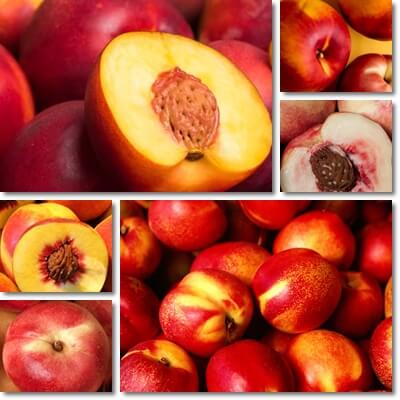We eat nectarines when they’re in season and often prefer them to peaches. But what are they more exactly? Are nectarines the same thing as peaches? Is a nectarine a type of peach? Are nectarines different from peaches? What kind of fruit are they and where do they come from?
What is a nectarine?
A nectarine is a botanical and culinary fruit. It’s a subspecies of peach hence the reason it looks so similar to one.
The scientific name for nectarines is Prunus persica var. nucipersica or Prunus persica var. nectarina. The scientific name is the same as that of peaches, Prunus persica, with an addition that indicates it’s different from an actual peach, nucipersica/nectarina.

Where do nectarines come from?
Botanically, nectarines are a subspecies of peach. They originated from peaches via a natural mutation around the 1600s. The natural mutation consisted of the gene that causes fuzz to grow on peach skin to become recessive, that is, to not manifest. By not manifesting, the resulting fruit grow a smooth skin.
As direct descendants of peaches, nectarines are considered a type of peach, a subspecies to be more exact. But because they are not quite the same thing as peaches, even though genetically related, and are commercially approached as a distinct fruit, they are also different from peaches. Neither assessment is technically incorrect so it’s valid to look at the nectarine as both a type of peach and a type of fruit that is not (quite) a peach.

Are nectarines like peaches?
You could say that nectarines are like peaches, to a certain extent. They are related, for one. Both nectarines and peaches are sweet, juicy, colorful and in season at the same time.
Nectarines and peaches have similar nutrition, and provide the same health benefits and side effects.
But nectarines don’t have the emblematic fuzz peaches have. And there are a few other differences as well.
There are hundreds of different cultivated varieties of peach, and at least several dozen different cultivated varieties of nectarine. And not all are exactly the same.
For one, there are visible organoleptic differences between nectarines and peaches.
One generalization that can be made is that nectarines tend to be naturally sweeter than peaches.
It has been theorized that the natural mutation that caused peaches to lose their fuzz and nectarines to emerge as a result, is likely to have been accompanied by other changes such as nectarines developing a sweeter taste.
Of course, there are peach varieties that are naturally extremely sweet and nectarine varieties that are not too sweet. Degree of ripening also plays an important part in taste and flavor profile.
In terms of nutritional profile, nectarines have a similar nutrition to peaches. However, the exact content of at least some essential vitamins and minerals likely differs slightly between the two fruits. Differences in nutrition facts are typically in the order of a few milligrams, so not very relevant to daily values considering the amounts the fruits are meant to be consumed. Also, soil quality and degree of ripeness also play an important part in the nutritional profile of the fruit, more so than variety.
When are nectarines in season?
Nectarines are in season right now in the Northern hemisphere. However, the fruit are extensively cultivated in both the Northern and Southern hemisphere so they are largely available all year round as a result. But the natural season for nectarines is late spring to late summer or early fall at the latest.
For the Northern hemisphere, that means that nectarines come into season mid to late May and are available until late August to early September. But not all regions have the same climate, not to mention weather conditions differ from year to year, sometimes quite significantly. Harvesting time ranges accordingly which means nectarines can become available at slightly different times of the year in different regions.
Early season nectarine varieties have also been developed. This has lead to the fruit becoming available as early as late April in some parts, and stay in season as late as early to mid October, but at this point their season intersects with that of nectarines from the Southern hemisphere.
In the Southern hemisphere, nectarine season is reversed.
Depending on the cultivar, nectarines are available October at the earliest to March at the latest. October through November is early season for nectarines in the Southern hemisphere. December through January is midseason. Late January through February is late season. March is very late season. For more informations check When Are Nectarines In Season?
What do nectarines look like?
Nectarines are medium-sized fruit, fairly similar in appearance to peaches, except for the fuzz. There are rounded and flattened varieties of nectarines, both having a dent at the end opposite to the stem and a groove going across the fruit from the stem to the base. Nectarine skin is tinged with red and yellow, even purple in some cultivars, and appears brighter and more colorful than that of peaches due to the lack of fuzz. The skin is smooth and bruises more easily compared to that of peaches.
Nectarines have golden yellow or white flesh, depending on variety, and one stone in the center of the fruit. The stone either clings to the fruit flesh in clingstone nectarines, or can be removed easily in freestone nectarines.
The stone has an intricate design of ridges and groves, and is brown to reddish brown, with a hard shell. Inside there is one single seed with a reddish-brown coat and a milky white, bitter kernel. Nectarine kernels are a source of toxic compounds and should not be consumed due to risks of toxicity.
What do nectarines taste like?
There are at least a few dozen different varieties of nectarines and not all taste exactly the same. Overall, nectarines are extremely sweet and flavorful fruit, with a strong fruity scent and juicy flesh, one of the best tasting fruit you can eat.
They taste their best when allowed to ripen completely, and allowed to ripen as much as possible on the tree. However, nectarines also continue to ripen off the tree.
Some varieties of nectarine have a bit of an acidic flavor but which does not overpower their sweetness. Underripe fruit have firm flesh, ripe fruit have soft flesh while overripe fruit are almost mushy. If underripe, nectarines might not taste very sweet or they might have a light bitter flavor with faint green flavor notes.
A slight bitterness may be perceived in the flesh clinging to the stone in some fruit cultivars. The kernels themselves taste bitter and should be detoxified so that toxic compounds occurring naturally in them are removed.
